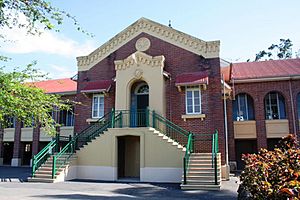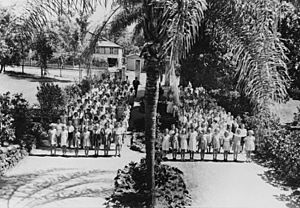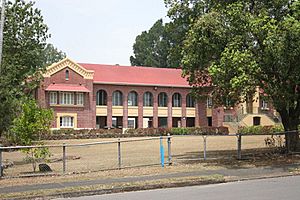Tully State School facts for kids
Quick facts for kids Tully State School |
|
|---|---|

Tully State School, 2011
|
|
| Location | 17 Mars Street, Tully, Cassowary Coast Region, Queensland, Australia |
| Design period | 1919–1930s (interwar period) |
| Built | 1936–1937 |
| Architect | Department of Public Works (Queensland) |
| Architectural style(s) | Classicism |
| Official name: Tully State School, Tully Rural School | |
| Type | state heritage (built) |
| Designated | 13 January 1995 |
| Reference no. | 601577 |
| Significant period | 1930s (historical) 1930s (fabric) 1936–ongoing (social) |
| Significant components | garden/grounds, school/school room |
| Lua error in Module:Location_map at line 420: attempt to index field 'wikibase' (a nil value). | |
Tully State School is a special school in Tully, Queensland, Australia. It's located at 17 Mars Street. This school was designed by the Department of Public Works (Queensland) and built between 1936 and 1937. It is also known as Tully Rural School. The school is so important that it was added to the Queensland Heritage Register on 13 January 1995.
Contents
History of Tully State School
How Tully Town Began
The town of Tully started in the early 1920s. This happened after the Queensland Government decided to build a sugar mill in the Tully River Valley in 1922. The mill was built from 1924 to 1925. With the mill came new roads, a railway, bridges, and the town of Tully itself. The town first began as a small, temporary settlement near Banyan Creek. It was officially surveyed and named Tully in April 1924.
Early School Days
A temporary school opened on 30 June 1924. It was in a metal shed at the sugar mill site. A proper timber school building was then built on the current school land in 1925–1926.
Becoming a Rural School
In the early 1930s, the Tully State School committee wanted the school to become a "rural school." This was because the area was growing fast. The rural school system started in 1917. In these schools, younger students learned regular primary subjects. Older boys learned practical skills like manual arts and farming. Girls learned home management and sewing. Becoming a rural school was a sign of importance for a town. These schools were a key part of education until the 1960s.
By March 1934, the school committee had raised money for new facilities. A new building for manual training and home economics opened on 5 November 1934. At this point, the school officially became Tully Rural School.
The Fire and Rebuilding
Sadly, on 22 November 1935, Tully Rural School was destroyed by fire. Students had to go to school in temporary places. They used the showgrounds, then the local Irish Club, and the CWA halls. They stayed there until the new brick building was finished.
Plans for the new, strong brick school were made by the Queensland Government Architect's office. The main architect at that time was Andrew Baxter Leven. He worked for the Queensland Government from 1910 to 1951. Other architects involved were William Jestyn Moulds and Harold James Parr.
During the 1930s Great Depression, the government started a plan to create jobs. This plan helped build government buildings like schools. The new Tully Rural School was built under this plan. It was started by Labor Premier William Forgan Smith.
The new school cost about £13,000. It had 8 classrooms, a head teacher's room, cloakrooms, and staffrooms. The area underneath the school was concreted. This created a large, sheltered play area for students.
A New Beginning and Special Programs
The new building opened for students at the start of the 1938 school year. The Hon. Percy Pease, who was the local Member of Parliament and Deputy Premier, officially opened it on 1 February 1938. A new head teacher, Charles Arthur Irish, was appointed. He was told to make Tully a truly great rural school.
He started many projects, including:
- A forestry plot with Kauri and Hoop pines and Indian Teak trees.
- Annual tree plantings in the school grounds. The gardens are now considered among the best in Queensland state schools.
- Raising poultry (chickens).
- A bushhouse for ferns.
- Garden rock walls.
- Manual training programs that made items for the school, like blackboard frames and library cupboards.
- A theatre built under the school.
- A sports oval next to the forestry plot.
School During Wartime
During the Second World War, student clubs at the school helped raise money. They supported the local Red Cross and Comfort Funds. Boys grew and sold vegetables. Girls cut and sold flowers from the school gardens. At this time, the garden had over 300 rose bushes! Students in home economics made clothes for children in Britain. Large events were held every year, and the money raised was shared between the school and groups supporting the war effort.
After the war, special Memorial Gates were built. These gates list the names of former students and teachers who served in the armed forces during the Second World War.
Changes Over Time
A secondary department (for high school students) was added to Tully Rural School in 1951. It was in a temporary timber building. This department operated until Tully State High School was built in Tully in 1964. Around this time, Tully Rural School went back to being called Tully State School. However, high school students continued to use the home economics and manual arts facilities at the primary school for several years.
Many other buildings have been added to Tully State School since 1937. However, these newer buildings are not part of the heritage listing.
School Building Description
Tully State Rural School is a one-story brick building. It has a corrugated iron roof with a small tower called a cupola on top. The building is raised up on brick supports, which creates an open play area underneath. The school has a central entrance with a pointed roof section called a gable. There are also two gables at each end of the building. These gables are decorated with a pattern that looks like machicolation (a castle-like design). The gables are connected by covered walkways called verandahs, which have since been enclosed.
The school grounds are very well cared for. They have many trees, palm trees, and bushes planted around them.
Why Tully State School is Special
Tully State School was added to the Queensland Heritage Register on 13 January 1995. This means it is a very important historical place.
Showing Queensland's History
Tully State School, built in 1936–1937, is important because it shows how Tully grew and became successful. This happened when the sugar industry expanded in the 1930s. It also shows that the government believed Tully was an important service center for the region during that time.
A Great Example of School Design
Tully State School is an excellent example of a school building designed for the North Queensland climate. It is raised above an open area underneath, has wide verandahs, and good ventilation. The use of brick and simple details was common for government buildings of that time. Tully State School continues the tradition of beautiful buildings made by the Queensland Public Works Department.
Beautiful Architecture
Tully State School is a fine example of buildings created by the Queensland Public Works Department. It is an outstanding school building designed by the office of the Queensland Government Architect. This office was considered one of the best architectural offices in Australia at the time.




